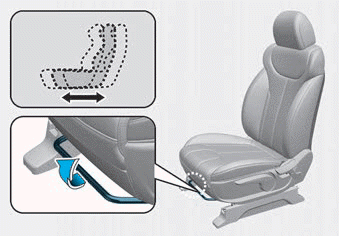Hyundai Palisade: Engine Control System / Variable Intake Solenoid (VIS) Valve
Description and operation
Installed on the intake manifold (VIS Valve 1) and the surge tank (VIS Valve
2), the Variable Intake manifold Solenoid (VIS) valves 1 and 2 control the vacuum
modulators, which activate the valves in the intake manifold and the surge tank.
These valves open or close according to engine condition. (Refer to below table.)

Specifications
Item
|
Specification
|
Coil Resistance (Ω)
|
30.0 - 35.0 [20°C (68°F)]
|
Schematic diagrams

Harness Connector

Repair procedures
| 1. |
Switch "OFF" the ignition.
|
| 2. |
Disconnect the VIS valve connector.
|
| 3. |
Measure resistance between the VIS valve terminals 1 and 2.
|
| 4. |
Check that the resistance is within the specification.
|
Specification : 30.0 - 35.0Ω [20°C (68°F)]
|
|
[VIS #1]
| 1. |
Switch "OFF" the ignition and disconnect the negative (-) battery terminal.
|
| 2. |
Disconnect the variable intake solenoid valve connector (A).
|
| 3. |
Disconnect the vacuum hoses (B) from the valve.
|
| 4. |
Remove the mounting nut (C) and then remove the valve from the surge
tank.
|
Variable intake solenoid valve mounting nut :
7.8 - 11.8 N.m (0.8 - 1.2 kgf.m, 5.8 - 8.7 lb-ft)
|

|
[VIS #2]
| 1. |
Switch "OFF" the ignition and disconnect the negative (-) battery terminal.
|
| 2. |
Disconnect the variable intake solenoid valve connector (A).
|
| 3. |
Disconnect the vacuum hoses (B) from the valve.
|
| 4. |
Remove the installation nuts (C) and then remove the valve from the
surge tank.
|
Variable intake solenoid valve mounting nut :
7.8 - 11.8 N.m (0.8 - 1.2 kgf.m, 5.8 - 8.7 lb-ft)
|

|
| • |
Install the component to the specified torque.
|
| • |
Note that internal damage may occur if the component drops.
In this case, inspect it before installation.
|
|
| • |
Keep foreign materials away from flowing into the valve.
|
|
| 1. |
Install in the reverse order of removal.
|
Description and operation
Description
Continuous Variable Valve Timing (CVVT) system advances or retards the valve
timing of the intake and exhaust valve in accordance with the ECM control signal
which is calculated by the engine speed and load...
Description and operation
Description
Installed on the high pressure fuel pump, the Fuel Pressure Regulator Valve
controls the fuel amount flowing into the injectors in accordance with the ECM
signal calculated based on various engine conditions...
Other information:
..
The Lane Keeping Assist (LKA) system
helps detect lane markers on the
road with a front view camera at the
front windshield, and assists the driver's
steering to help keep the vehicle
between lanes.
When the system detects the vehicle
straying from its lane, it alerts the
driver with a visual and audible warning,
while applying a counter-steering
torque, trying to help prevent the
vehicle from moving out of its lane...
Categories
The front seat can be adjusted by
using the levers located on the outside
of the seat cushion. Before driving,
adjust the seat to the proper
position so that you can easily control
the steering wheel, foot pedals
and controls on the instrument
panel.

read more



 CVVT Oil Control Valve (OCV)
CVVT Oil Control Valve (OCV) Fuel Pressure Control Valve (FPCV)
Fuel Pressure Control Valve (FPCV)




